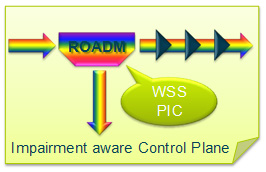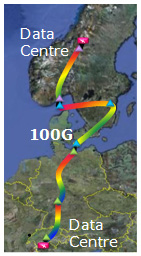Photonic Switching and Experimental Photonic Facilities
Optical networking technologies enable a robust and scalable transport Dense Wavelength Division Multiplexing (DWDM) network that meets users’ increasing demands for dedicated, high-capacity and high-quality services.
Focus of research:
- Identifying fundamentals and principles (such as wavelength counts and bands, optical amplifiers, photonic fibre switches, optical add/drop and transponders).
- Investigating and testing state-of-the-art and emerging optical networking technologies in order to determine how GÉANT and the NRENs can develop their networks to meet future demands.
- Defining test scenarios and plans, and testing in collaboration with suppliers.
- Establishing and running a demonstration facility.
- Analysing and documenting results.
To be more technically specific, the review and research covers the following:
- Fundamentals and principles:
- Wavelength counts and bands: the review covers the successively defined transmission windows; the broadening transmission spectrum; capacities; Wavelength Division Multiplexing (WDM) grids and channel-, frequency- and wavelength-calculation formulae; and increasing the wavelength count (by increasing the number of channels and/or increasing the bandwidth for each channel).
 Since there are many principles of optical signal amplification, the review of optical networking technologies has concentrated on the four generally used types: rare-earth doped fibre, semiconductor, Raman and parametric.
Since there are many principles of optical signal amplification, the review of optical networking technologies has concentrated on the four generally used types: rare-earth doped fibre, semiconductor, Raman and parametric. - The switching review has considered whole fibre capacity and the switching of bands rather than the switching of individual wavelengths, and addresses the principles of photonic switching rather than the construction principles of switching networks.
- The review of Optical Add/Drop Multiplexers (OADMs) addresses the adding or dropping of wavelength channels (lambdas) in WDM systems using either automated lambda processing or simple optical filter devices offering static add/drop capability, together with tunable filters, Photonic Integrated Circuits (PICs) and Optical-to-Electrical-to-Optical (OEO) conversion.
The review of transponders covers 10 G, 40 G and 100+ G technology; regeneration techniques; Forward Error Correction (FEC); and the basic modulation methods and formats behind signal coding.
- Optical processing techniques such as Optical Packet Switching (OPS) and Optical Burst Switching (OBS), light-trails, optical circuit switching networks, optical hybrid switching technologies and all-optical wavelength conversion.
- Photonic interoperability and the use of alien wavelengths (AWs) via DWDM systems in the context of CBF.
- Operations, Administration, Maintenance and Provisioning (OAM&P) for multi-vendor/multi-domain scenarios.
- Impairment-aware control plane considerations.
Results:
- The results of the research and evaluation have been documented in Deliverable DJ1.2.1: State-of-the-Art Photonic Switching Technologies.
- Based on early findings, the research team (or Task) is conducting 40G and 100G testing with advanced modulation formats; further study of multi-domain alien waves carried over CBFs; research into GMPLS-controlled optical networks with and without impairment awareness; more detailed studies of intelligent control plane technologies.
- The Task is also developing a Path Computation Element (PCE) module, designing and developing control plane (CP) extensions for alien wavelength support and/or different modulation formats, and carrying out simulation studies of CP extensions along with PCE integration in the GMPLS simulation platform.
|
 TNC2011 Abstract: Application of Pulsed Pump Optical Parametric Amplifier for De-multiplexing of 107 Gb/s OTDM Signal
TNC2011 Abstract: Application of Pulsed Pump Optical Parametric Amplifier for De-multiplexing of 107 Gb/s OTDM Signal
